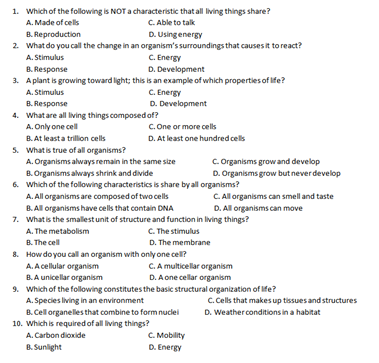1. Which of the following is NOT a characteristic that all Iiving things share? A. Made of cells B. Reproduction C. Able to talk D. Usingenergy
Cells and Tissues
The smallest, basic, and structural component of the body is a cell. It is the basic functional unit of life. No organism can exist on this Earth without a cell. Thus, it is the fundamental unit. These cells perform the major functions of the body. The term cell was given by Robert Hooke, who stated that all organisms’ bodies, whether unicellular or multicellular, are made of cells. In single-celled organisms such as amoeba and protozoa, all the body functions are performed by a single cell. The multicellular organisms have collective cells which perform a specific function in the body.
Types of Tissues
The smallest, basic, and structural component of the body is the cell. It is the functional unit of life. No organism can exist on this Earth without a cell. An organism's body, whether unicellular or multicellular, is made of cells. In unicellular organisms such as amoeba and protozoa, all the body functions are performed by a single cell. The multicellular organisms have collective cells which perform a specific function in the body. Tissues are a group of cells that work together to perform a particular function in the body. They make a series of networks or a system to coordinate with the different tissues in the body, forming a tissue system. The word tissue is derived from the Latin word 'weave.' Plants and animals have various kinds of tissue systems that differ in their work and composition according to the different requirements.
Tissue System
The smallest, basic, and structural component of the body is the cell. It is the functional unit of life. No organism can exist on this Earth without a cell. An organism's body, whether unicellular or multicellular, is made of cells. In unicellular organisms such as amoeba and protozoa, all the body functions are performed by a single cell. The multicellular organisms have collective cells which perform a specific function in the body. Tissues are a group of cells that work together to perform a particular function in the body. They make a series of networks or a system to coordinate with the different tissues in the body, forming a tissue system. The word tissue is derived from the Latin word 'weave.' Plants and animals have various kinds of tissue systems that differ in their work and composition according to the different requirements.

Step by step
Solved in 2 steps




